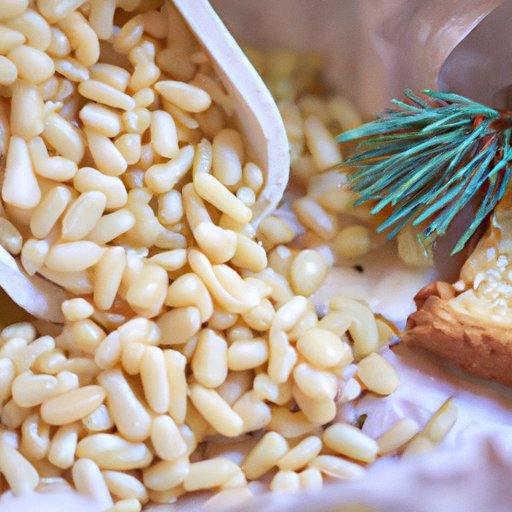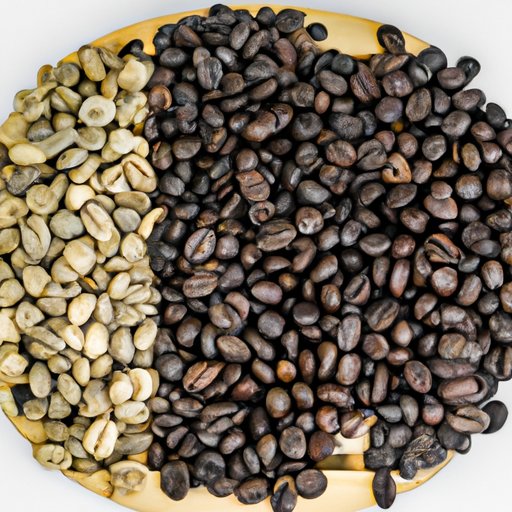
I. Introduction
If you love cooking, you might have encountered a common problem of burning or unevenly toasting your pine nuts. Pine nuts, also known as pignoli, have a delicate flavor and texture that can be easily ruined if not properly toasted. That’s why we’re here to help you master the art of toasting pine nuts with this step-by-step guide and helpful tips and tricks.
II. Step-by-Step Guide to Toasting Pine Nuts
Before jumping into different toasting methods and their effects, let’s start with the basic and foolproof process of toasting pine nuts.
1. Preheat oven to 350 degrees Fahrenheit.
2. Divide pine nuts into batches according to the amount needed for your recipe, as you don’t want to overcrowd the baking sheet.
3. Spread pine nuts evenly on a baking sheet lined with parchment paper or aluminum foil.
4. Place in preheated oven and monitor closely, as pine nuts toast quickly and can easily burn. You only need about 5-7 minutes, but the exact time may vary depending on your oven and the amount of pine nuts.
5. Remove from oven once golden brown and fragrant. Shake the nuts around on the baking sheet to make sure they toast evenly.
6. Let cool before using or storing in an airtight container at room temperature or in the fridge or freezer for longer shelf life.
III. Different Toasting Methods and Their Effects on Flavor and Texture
While the oven method is the most common and reliable way to toast pine nuts, you might prefer different methods for various reasons such as time, convenience, or taste. Here are a few other options you can try.
1. Microwave: Spread the pine nuts on a microwave-safe plate and microwave on high for 1 minute. Check and shake the nuts, then continue to microwave in 15-second intervals until they are lightly browned and fragrant.
2. Stovetop: Heat a skillet over medium heat and add the pine nuts. Stir frequently until they are golden brown and have a slightly nutty smell, which usually takes around 5-10 minutes. You can also add a small amount of oil or butter for extra flavor and crispness.
3. Grill: Place the pine nuts in a grill basket or directly on a grill rack over medium heat. Grill for 2-3 minutes, stirring occasionally, until the nuts are toasted and charred on the surface. This method gives the nuts a smoky flavor and is perfect for outdoor cooking.
While each method can produce delicious results, there are noticeable differences in flavor and texture. Oven-toasted pine nuts have a mild and slightly sweet taste with a soft, chewy texture. Microwave-toasted nuts have a slightly drier texture and stronger taste, sometimes with burnt hints. Stovetop-toasted nuts have a more robust and rustic flavor with slightly broken pieces, while grilled nuts have a distinct smoky aroma with a crispy outside and soft inside. So it’s up to you to choose the method that suits your preference and recipe.
IV. Toasted Pine Nuts in Recipes
Once you’ve mastered the toasting technique, you can incorporate pine nuts in various dishes for added depth and crunch. Toasted pine nuts are a versatile ingredient that pairs well with both sweet and savory flavors. Here are a few suggestions to inspire you.
1. Salads: Top your favorite salad with toasted pine nuts for a nutty crunch. You can try a classic Caprese salad with mozzarella, basil, and pine nuts, or a spinach salad with strawberries, feta cheese, and pine nuts.
2. Pasta dishes: Toss cooked pasta with pesto, roasted cherry tomatoes, and toasted pine nuts for a simple yet flavorful meal. Or make a creamy spinach and mushroom pasta with toasted pine nuts and Parmesan cheese.
3. Appetizers: Add a Mediterranean touch to your appetizer platter with homemade hummus, tzatziki, or babaghanoush topped with pine nuts. Or wrap bacon-wrapped dates stuffed with goat cheese and pine nuts.
For more recipe ideas, try these delicious recipes that use toasted pine nuts: pesto pasta with spinach and toasted pine nuts, roasted butternut squash and kale salad with pine nuts and feta, and potato gnocchi with toasted pine nuts and sage butter sauce.
V. Tips and Tricks for Perfectly Toasting Pine Nuts
While toasting pine nuts is fairly simple, there are a few tips and tricks that can help you achieve the best results every time.
1. Test pine nut freshness by tasting before toasting. If they taste rancid, moldy, or bitter, discard them and purchase a fresh batch.
2. Store pine nuts properly to maintain freshness. Keep them in an airtight container away from heat, light, and moisture, such as in a pantry or fridge. Alternatively, freeze them for up to 6 months.
3. Look for golden brown color and nutty aroma to determine if they are properly toasted. Do not rely solely on visual cues, as pine nuts can easily burn and taste bitter.

VI. Roasting Variations for Unique Flavors
If you want to jazz up your toasted pine nuts, you can experiment with different spices, herbs, and oils to add a pop of flavor and aroma.
1. Add spices like cinnamon, smoked paprika, or chili for a sweet, smoky, or spicy kick.
2. Try fresh or dried herbs like rosemary, thyme, or oregano for a fragrant and earthy note.
3. Use different oils like olive oil, sesame oil, or truffle oil for a rich and distinctive taste.
You can mix and match these variations or pair them with specific cuisines or occasions. For example, add cumin and coriander to toasted pine nuts and toss them with couscous and raisins for a Middle Eastern-inspired dish. Or sprinkle them with sugar and nutmeg and serve with hot cocoa for a cozy winter treat.
VII. Health Benefits of Pine Nuts and Toasting Nuts
Besides being a tasty and versatile ingredient, pine nuts offer numerous health benefits when consumed in moderation.
1. Pine nuts are a good source of healthy fats, protein, and fiber, which can help regulate blood sugar, cholesterol, and weight. They also contain antioxidants, vitamins, and minerals that support immune and brain function.
2. Toasting nuts can release nutrients and promote easier digestion, as it breaks down phytic acid and reduces anti-nutrients that can inhibit mineral absorption. Plus, it gives nuts a crispy and crunchy texture that enhances the eating experience.
However, keep in mind that pine nuts are high in calories and fat, so consume them in moderation. Also, be aware of any allergic reactions to nuts and consult your doctor if you have any concerns.
VIII. Cultural Significance of Pine Nuts
Pine nuts have a rich cultural history and significance in various cuisines around the world. For example, in Italy, pine nuts are often used in traditional dishes like pesto and pizza. In Greece, pine nuts are a common ingredient in spanakopita and baklava. In Morocco, pine nuts are used in tagines and couscous dishes. In Native American culture, pine nuts are highly prized as a spiritual food and used in healing and ceremony.
You can explore these cultural recipes and appreciate the legacy of pine nuts. Also, consider sourcing pine nuts from sustainable and ethical sources to support local communities and preserve biodiversity.
IX. Conclusion
Toasting pine nuts is an art that requires careful attention and experimentation. By following this step-by-step guide and trying different methods and recipes, you can unlock the full potential of pine nuts and elevate your cooking skills.





